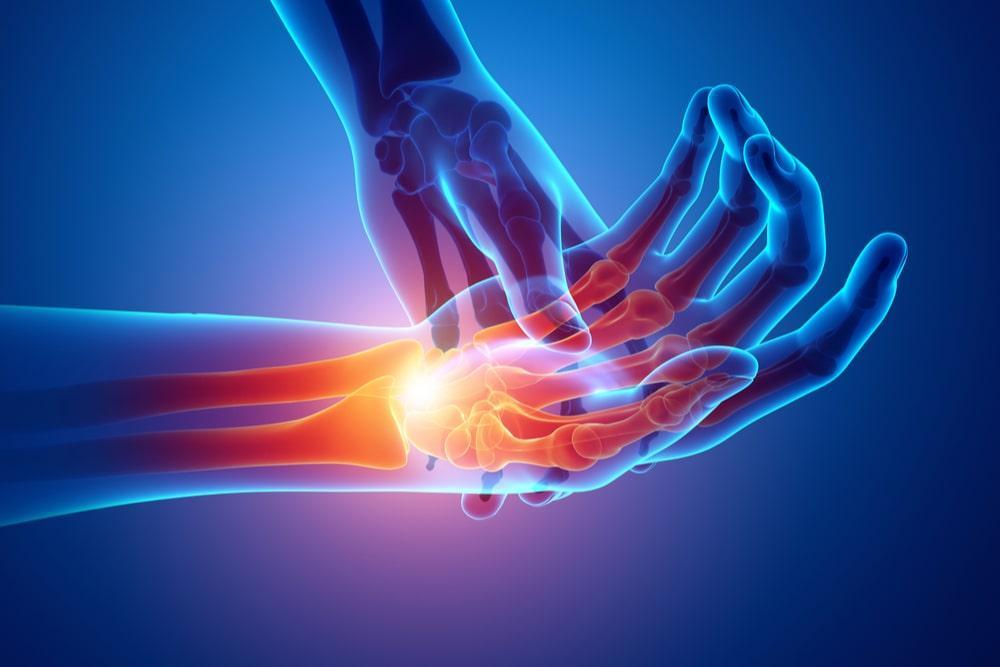Overview
What is Wrist Pain?
Wrist Pain is any discomfort experienced in the wrist is referred to as wrist pain. It may result from a number of problems, such as
- acute harm
- gout
- carpal tunnel syndrome
- arthritis- Rheumatoid arthritis (RA) or Osteoarthritis (OA)
Despite being a small portion of the body, the wrist is made up of eight bones, as well as ligaments and tendons, making it a rather fragile area.
Your wrist comprises a sophisticated assembly of:
- Bones.
- Muscles.
- Nerves.
- Tendons.
- Ligaments.
- Blood vessels
Wrist Pain Location
Orthopedic doctor, Dr. Preetesh Choudhary may categorize wrist pain based on the specific side of your wrist that is affected:
- Ulnar wrist pain: Discomfort located on the side of your wrist where the ulna, one of the bones in your forearm, is positioned. The ulnar side of your wrist corresponds to the side where your pinkie finger is located.
- Radial wrist pain: Discomfort felt on the side of your wrist where the radius, the other bone in your forearm, is situated. The radial side of your wrist corresponds to the side where your thumb is located.
Regardless of the side affected, Dr. Preetesh Choudhary will diagnose and address the underlying cause of your pain and will provide wrist pain treatment solutions.

Symptoms & Causes
Symptoms
Some individuals may experience a dull or achy pain, while others may feel sharp pain, depending upon the cause.
Additionally, other symptoms may manifest alongside the pain. For instance, injuries like wrist sprains may lead to swelling and bruising.
Numbness, tingling, and weakness in the hand may occur in cases of carpal tunnel syndrome.
Other possible symptoms include:
- Stiffness: Sensations of stiffness may be felt in the wrist and possibly extend to the fingers.
- Difficulty gripping objects: Wrist pain can impede the ability to grasp or hold onto objects comfortably.
- Clicking sound during wrist movement: This may become more pronounced following periods of rest.
Symptoms may initially be mild and worsen over time. Initially, pain might only occur during specific activities, but as the condition progresses, it could persist even at rest. Numbness may also advance to the point where sensation loss prevents the perception of temperature changes, leading to instances of dropping objects.
Causes of Wrist Pain
Causes of Wrist Pain from Injuries
Various forms of physical trauma to the wrist can result in discomfort. Among the most prevalent injuries associated with wrist pain are:
- Overuse and repetitive strain injuries.
- Wrist sprains.
- Sports-related injuries.
- Falls.
- Bone fractures.
- Nerve injuries or instances of nerve compression.
Medical Conditions Associated with Wrist Pain
Common underlying conditions contributing to wrist discomfort include:
- Carpal tunnel syndrome.
- Tendinitis in the wrist.
- Arthritis affecting the wrist.
- Wrist bursitis.
- Ganglion cysts in the wrist.
- Infections.
- Kienböck’s disease.
Diagnosis & Treatment
Diagnosis
In the course of the physical examination, for wrist pain treatment orthopedic doctor, Dr. Preetesh Choudhary may:
- Assess your wrist for tenderness, swelling, or any abnormalities in shape.
- Request you to perform wrist movements to ascertain any limitations in your range of motion.
- Evaluate your grip and forearm strength.
Imaging examinations may involve:
- X- Ray
- CT- Scan
- MRI
- Ultrasound
In case if the pain is not detected, following options can also be tried:
- Arthroscopy
- Nerve Tests, or Nerve conduction study
Wrist Pain Treatment
Wrist pain Treatment approaches for wrist issues vary significantly depending on factors such as the type, location, and severity of the injury, as well as your age and overall health.
Non- Surgical Treatments:
Medications:
Over-the-counter pain relievers like ibuprofen (Advil, Motrin IB) and acetaminophen (Tylenol) may alleviate wrist pain. Stronger pain medications may be prescribed if needed. Corticosteroid injections may also be an option for certain conditions.
Therapy:
Physical therapy can provide tailored treatments and exercises for wrist injuries and tendon problems. In cases requiring surgery, physical therapy aids in rehabilitation post-operation.
For wrist fractures, realigning the bone fragments is necessary for proper healing. A cast or splint helps maintain alignment during the healing process.
For wrist sprains or strains, wearing a splint can protect the injured tendon or ligament during recovery, especially for overuse injuries caused by repetitive motions.
Surgical- Wrist Pain Treatment
In certain situations, surgical intervention may be required. Instances include:
- Bone fractures: Surgery may be necessary to stabilize fractured bones and facilitate healing by connecting bone fragments with metal hardware.
- Carpal tunnel syndrome: Severe symptoms may warrant surgical intervention to release pressure on the nerve by cutting the ligament forming the tunnel.
- Tendon or ligament repair: Surgery may be indicated to mend ruptured tendons or ligaments.
Prevention
How can you prevent wrist pain effectively?
Many individuals who experience wrist discomfort regularly use a computer and keyboard. Here are some measures to prevent wrist pain:
- Adjust your keyboard height to avoid upward bending of the wrists while typing.
- Take regular breaks from typing to allow your hands to rest.
- Utilize a wrist rest with your keyboard, mouse, or trackpad.
- Alternate the use of your dominant hand for mouse operation, or train yourself to use the mouse with your non-dominant hand.
- Additionally, adhere to these general safety guidelines to minimize the risk of wrist injuries:
- Always wear a seatbelt while driving.
- Use appropriate protective gear for all work, activities, and sports.
- Ensure that your home and workplace are free from clutter that could cause tripping hazards for yourself and others.
- Always utilize the correct tools or equipment at home to reach objects; never stand on chairs, tables, or countertops.
- If you experience difficulty walking or have an increased risk of falls, consider using a cane, walker, or other assistive devices.